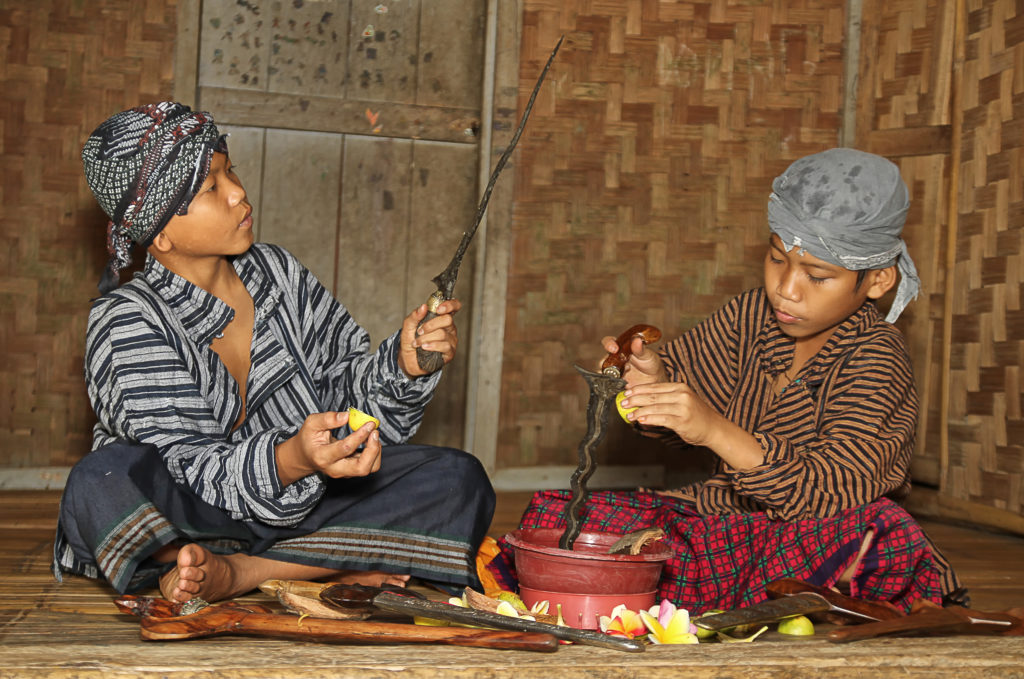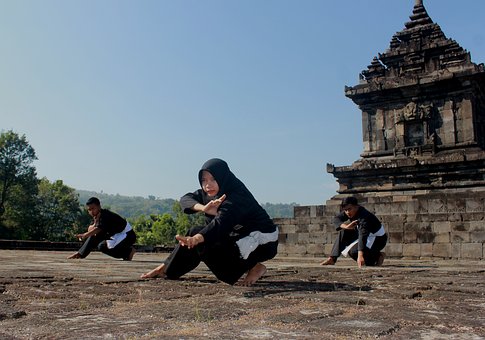Pencak silat is a unique and distinctive form of martial arts that is rooted in the culture and tradition of the Malay people.
As a race of people, Malay refers to the common culture, language and traditions of those who inhabited what is now known as Indonesia, Malaysia, Brunei, Southern Philippines, Southern Thailand and East TImor.
Similar to muay thai, silat has a long history and was used and practiced on the battlefields by warriors and as self defense by civilians.
There are hundreds of styles of silat but all are rooted in combat arts and include the use of weapons in addition to unarmed combat.
This post will look at this unique form of Malay martial arts and specifically:
- The origin of Silat martial arts
- The characteristics of Silat
- The training of this martial art
- Different styles
- Notable practitioners
Origins of Pencak Silat
The origin of pencak silat are not fully known with varying accounts of how this martial art began.
From historical records and accounts Pencak silat roots date back as early as the 6th century.
However verifiable records are difficult to find in relation to the origins of pencak silat.
One reason for this is the tradition and secrecy that surrounded the teaching and passing on of these martial arts in the Malay areas.
The teachings of Pencak Silat martial arts were passed down orally and written records are virtually non-existent.

However one common theme running through origin stories of pencak silat is that people founded these styles based upon the characteristics, movements and behavior of animals in their surrounding environment.
One such story tells of a woman witnessing a tiger and giant hawk fight and imitating the fighting movements of the two animals in a self defense situation to ward off a group of drunks.
Movements, techniques and stances in pencak silat have animal names including the harimau or tiger and garuda putih or white eagle.
Again similar to muay thai and muay boran, silat martial arts styles and their development are linked with ancient battles and wars waged among ancient kingdoms as they sought to expand and defend their territories.
Modern History
During the colonial era and colonial rule of the Dutch in particular who brought in Chinese workers to Indonesia, elements of Chinese martial arts became integrated into the local Malay martial arts.
The term pencak silat itself originated from the Indonesian Pencak Silat Association which was established in 1948.
The term was adopted by the International Pencak Silat Federation founded in 1980 by Indonesia, Malaysia, Singapore and Brunei Darussalam.
This term is now recognized globally as the umbrella term for all styles of Silat martial arts.
Today Pencak silat is a competitive sport and in 2018 it made its debut at the Asian Games in Indonesia.
Characteristics of Pencak Silat
Pencak silat is comprised of four components which are:
- Art
- Sport
- Self Defense
- Mental-Spiritual
Art
As an art, pencak silat expresses movement and rhythm and as a performance art or dance often accompanied with traditional music.
This is of course apart from being a unique form of the martial arts and fighting systems from the Malay region.
In some parts of Indonesia, it is performed during harvest festival, wedding ceremonies and public holidays and is recognizable by the local people.
Sport
As a sport, pencak silat focuses on physical endurance, conditionig and fitness to perform techniques with dexterity.
Agility and power in movements is the target of the practitioner to be able to perofrm well in sport competitions.
Self Defense
As a self defense system, pencak silat is focussed on defending oneself against multiple attackers. Striking first and with devastating effectiveness to quickly neutralize threats are the hallmarks of the self defense aspects of this martial art.
Mental-Spiritual
As a traditional martial art. focus on breathing and spiritual awareness are a key part of pencak silat. Moral behavior and ethics are notable qualities that the martial art seeks to develop.
Building virtue and good character as well as nourishing and growing one spiritual being are important in this aspect of pencak silat martial arts.

Styles of Pencack Silat
Hundreds of styles of pencak silat martial arts are known to exist with the majority found in the areas of Indonesia, Malaysia, Singapore, southern Thailand and the southern Philippines.

The styles are associated with the geographical region they originate from and are also attributed to animal movements, notable people and spiritual or combat principles.
As stated there are hundreds of style of silat martial arts but each are related in that they are rooted in Malay history and culture and contain both unarmed and weapons systems.
- Bersilat is a style from Malaysia and is also found in the southern Philippines.
- Styles such as Rikeson silat focus on nerve strikes.
- Cipecut silat teaches the use of the practitioner’s sarong for throwing and controlling the opponent.
- Undukayam silat is named after the scracthing action of the hen on the ground.
- Menangkabau silat is named after the Meneagkabau people.
Training in Pencak Silat
Like all martial arts the training in silat begins with stance and foot work.
The familiar horse stance, common in most Asian martial arts are key as well as unique postures and other stance and specific footwork movements.
These are all key in developing the ability to move with good balance to be able to execute techniques with power and accuracy while remaining in good balance.
Set forms or kata as they are known in Japanese martial arts also are practiced and performed.
As in other martial arts the main purpose of the forms is to pass down the style’s techniques and combat applications in an organised manner.
Set forms also served as a method of physical conditioning and public demonstration.
Weapons forms and sparring as well are part of the training.

The common weapons across pencak silat include the kris (wavy patterned sword), spear, machete, stick, sickle and the sarong.
Agricultural tools often are used and developed for the dual purpose of farming and combat.
Notable Silat Practitioners
Dan Inasanto former student of Bruce Lee and martial arts veteran is a notable Guru of the silat system. In an interview from 2007, Inasanto credits Bruce Lee to having introduced him to several Silat masters.
Iko Uwais former stuntman and now actor who has appeared in films and television shows such as The Raid and Mile 22 (2018) and the current Netflix series Wu Assassins, is a notable pencak silat martial arts practitioner.
The 2011 movie, The Raid features pencak silat martial arts in the fight choreography and helped to bring even more recognition and global appeal to the Pencak Silat.
How to Learn Pencak Silat
Obviously the original region where the martial art developed and orgiinated from would be the best place possible to learn.
In terms of muay thai this is of course Thailand and for silat this would be in the Malay region with Indonesia being one of the main places to travel to and learn.
If you are able to travel and want to learn this martial art the post below gives information on 5 great places to learn and train:
If you are not able to travel and still want to learn some techniques and get a better understanding of this martial art there are also resources available in the form of apps.
Check out this link for one such app but there are a few others if you are interested.
For online courses there are websites such as the ones below:
http://onlinetraining.pcksilat.com/
Outside of Indonesia and the Malay region pencak silat schools and instructors teach the art in countries such as Australia, in the UK and the US.
With a little google research you should be able to find a qualified instructor near you or make use of the apps and online resources to also learn the basics.



